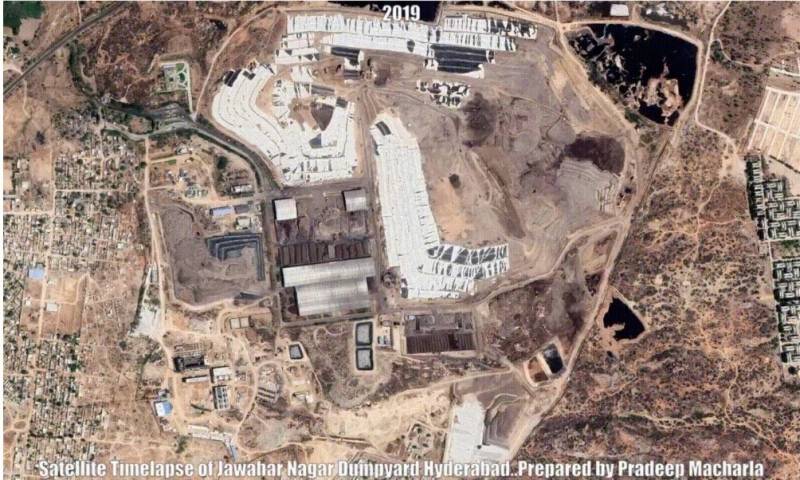Satellite Imagery of Hyderabad's Jawaharnagar dumpyard reveals city's waste dilemma
By Dheeshma
Hyderabad: It is the primary responsibilities of any urban local body to maintain general sanitation and waste management. However, this remains a challenge to the Greater Hyderabad Municipal Corporation (GHMC).
GHMC generates waste of about 5,500 to 6,000 Metric Tonnes per day, and it’s wholly processed at a 135-acre Jawahar Nagar unit which is at the middle of around 30 villages and colonies. 14 satellite imagery of Jawaharnagar dump-yard reveals the transformation of Hyderabad’s biggest dump-yard from 2003 to 2019.
 2003 satellite imagery of Jawaharnagar dump-yard
2003 satellite imagery of Jawaharnagar dump-yard
 2019 satellite imagery of Jawaharnagar dump-yard
2019 satellite imagery of Jawaharnagar dump-yard
Pradeep Goud Macharla, a GIS and Remote Sensing enthusiast, in his latest tweet, has published a GIF of 14 satellite images which indicates how the colossal pile of garbage has affected over 10,000 families living in the area.
#Hyderabad #Jawaharnagar dump-yard satellite imagery time-lapse(2003-2019).An estimated 14 million tonnes of garbage has been deposited since 1994. India need a Long term solution to keep up with garbage demand.@bonthurammohan @HiHyderabad @gandhi_pv @swachhhyd @PankajSethi00 https://t.co/ReSvbhzCTR pic.twitter.com/u8CbzbKKsJ
— Pradeep Goud Macharla 🌍 (@Macharlazz) September 25, 2019
Thakur Rajkumar Singh, founder of Human Rights and Consumer Protection Cell, said, “To date, neither the Telangana government nor GHMC has implemented Solid Waste Management Rules, 2016, which says waste has to be segregated at its source. This means waste has to be categorised into bio-degradable and non-bio-degradable at every household and other locations and collected separately. However, this is not happening anywhere in Hyderabad.”
At every corner of every street in this city, one can find an overflowing garbage bin. However, to date, the government has not come out with a policy on waste management. The 2016 Solid Waste Management Rules mandate the at-source segregation of waste to channelise them by recovery, reuse and recycle. As per the rule, waste generators should segregate it into three streams — biodegradables, dry (paper, plastic, wood, metal, etc.), and domestic hazardous waste (napkins, diapers, mosquito repellents) — before handing them over to collectors.
“Most of the time, non-segregated waste is burned down to hazardous carbon smoke. In many instances, the waste also contains bio-medical substances which can cause health hazards. GHMC has to come up with some concrete ideas. Capping dump-yards is like handling them at the end-point. Instead, we need to deal with them at the starting point,” adds Rajkumar.
Deepthisree Nagar dump-yard near Ameenpur is turning into another Jawaharnagar, which is managed by Ramky Enviro Engineers Limited. Tones of non-segregated waste are getting dumped at Deepthisree Nagar each day. Around 16 lakes in Ameenpur can get polluted by this. Ameenpur is the only bio-diversity site in an urban area in Telangana.
Meanwhile, the residents of newly formed Dammaiguda Municipality are also suffering due to the pathetic condition of dumping yard in the area. The municipality is today a breeding ground for mosquitoes and diseases Leachate is seeping out from dump yard into surrounding residential colonies and ponds- Ahmed Guda, Karinguda, Dammaiguda in Dammaiguda.
Local leaders in the area including former Sarpanch, Anuradha Yadagiri Goud and former MP, Sarpanch Narender Reddy, urged the dumping yard owners to take immediate preventive measures. Reacting to the situation the residents said, “Mosquitoes, dogs and pigs would soon spread disease to the residential colonies, and the owners of the dumping yard would have to respond with the money earned from the dumping. It is their basic responsibility to ensure the safety of the ponds and colonies surrounding the yard.”
Dr Lubna Sarwath, Convener of Save Our Urban Lakes (SOUL) in Hyderabad, opined, “The government is supposed to bring in a waste management policy and implement it. We have always recommended a ward-wise decentralisation of waste segregation. Door-To-Door ward-wise segregation will enroot the dump yards in the entire city, including the one at Jawaharnagar. Ramky is getting paid for every kilogramme that they dump at Jawaharnagar. To sustain Ramky, the city is stinking,”
She added that legally, the next step has to be held at the ward level. The entire biodegradable waste from a ward has to be decomposed within that area, and only non-bio degradable waste has to go to dump-yards.
Reacting to the long-standing issue of waste management in the city, Arvind Kumar, Principal Secretary of Municipal Administration, said in a press note, “The processes involved in the collection of garbage to its transfer, dumping and final processing is fraught with several processes and implementation challenges. It needs to be addressed to ensure the scientific management of waste management in a standardised mechanism.”
“Construction and demolition (C&D) waste remain a challenge, and the gap between the present capacity to process C&D waste and what GHMC currently generate is huge. One needs to work out a sustainable mechanism for processing C&D waste,” he added.
Meanwhile, GHMC on Sunday appointed an eight-member committee to study the best practices in waste management from Indore, Mysuru and Surat and see what could be adapted in Hyderabad. The committee will have Sujata Gupta, Special Officer, Sanitation, Greater Hyderabad Municipal Corporation as member-secretary.